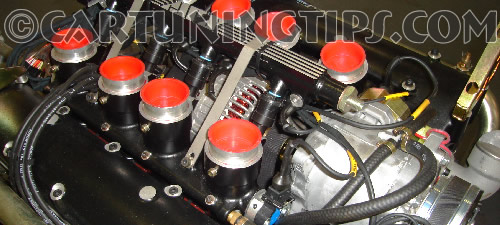Explore What is port matching an engine"
The ports on the engine allow the air into the engine and the exhaust gases out.
There are typically 2 per cylinder, an inlet and an exhaust. The inlets or ports are joined to the manifold or headers via a gasket.
Whenever you join two surfaces there is typically a step or at the very least a ridge or seam where they meet.
 These ridges or seams cause turbulence and break up the flow of the air into the engine.
These ridges or seams cause turbulence and break up the flow of the air into the engine.
This turbulence slows up the air and reduces the efficiency of the engine. When port matching is applied to an engine the intake and exhaust manifold or headers are matched up to the engine block ports to avoid this step.
In its simplest DIY form a grinding wheel is used to cut away excess metal and widen the receiving port. (Only ever attempt this on very basic production engines, most performance engines require specialist work to improve the air flow.)
This reduces turbulence and allows a better flow into the engine. We need to point out that this is a very exact science and should only be attempted at home on basic engines. Anything remotely advanced and you risk ruining the airflow into the engine.
For best results you will need a proper flow bench and a computerised CNC milling machine where optimum results can be achieved.

While many believe that bigger ports and manifolds are better for performance this is not always the case. In some applications reducing the port or changing the angle of the inlet port are what give a power gain.

In a race environment an inlet on an engine is completely re machined with the old port blocked up with metal effectively moving the entire port.
The aim is to straighten the flow of air into the engine. Most standard engines have ports at right angles to the cylinder and the air has to bend through 90 degrees as it flows into the engine.
On a high performance engine you will get a better flow rate if you can reduce the air intake angle into the cylinder.
The induction length plays a part and there is an optimum size, the trick is balancing the lag at the beginning of the intake stroke with the additional push of air near the end of the intake.
This will need to take into account the configuration of the engine and the desired power band. Inlet valves and engine head design will usually prevent the ideal 180 degree (straight) inlet but you should be able to get much better than the standard 90 degree bend.
See also the article on Gas Flowing a head as this is very closely related to port matching and the terms are often used interchangeably. Gas flowing a head will usually include work on the valve seat and valves.
Check out TorqueCars new YouTube channel, and see their awesome new content...
Feedback
Please use our forums if you wish to ask a tuning question, and please note we do not sell parts or services, we are just an online magazine.
Help us improve, leave a suggestion or tip
One Response to “What is port matching an engine”

i have a opel 2 litre engine with a 1.6 l head but now the engine keeps over heating maybe u can help me with a tip what to look for as the motor has been done twice now with new rings but still it overheats .i put the head on as i couldnt fix the fuel injection so i put a carburetor on